.
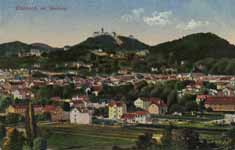
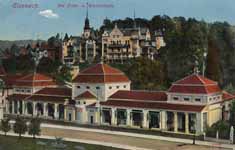
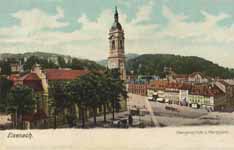
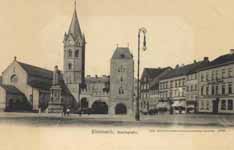
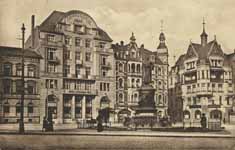
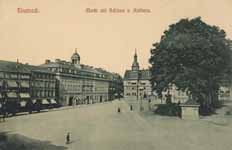
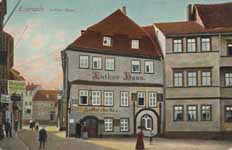



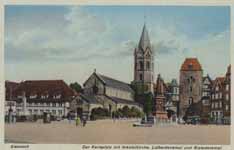
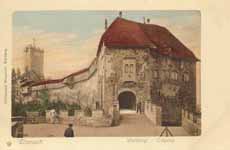
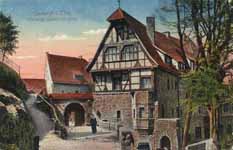

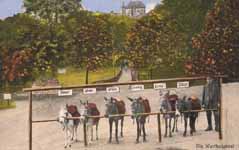
Eisenach
Eisenach is a city in Thuringia, Germany. It is situated between the northern foothills of the Thuringian Forest and the Hainich National Park. Its population in 2006 was 43,626.
History
The history of Eisenach is linked with the Wartburg Castle, which was built according to legend in 1067. There were at least three settlements below the castle, that merged to a common city in the second half of the 12th century. This town, Eisenach, was first mentioned in 1180.
Several now legendary events took place on the Wartburg in the following decades, best known is the "Singers' Contest on the Wartburg" (Sängerkrieg, which is part of the Tannhäuser legend).
After the Thuringian War of Succession (1247–1264) Eisenach became subject to the Wettin dynasty of Meißen. Later several mini states were established in what is now Thuringia, and Eisenach became a principality on its own in 1521. In 1809 Eisenach became part of the duchy of Saxe-Weimar-Eisenach.
Eisenach was the place where Martin Luther lived as a child, although he was not born there, and later for his receiving protection by Frederick the Wise after having been pursued for his religious views. It was while he was staying at Wartburg Castle that he translated the New Testament into German.
The town is famous as the birthplace of Johann Sebastian Bach as well.
The Social Democratic Party of Germany was founded in 1869 in Eisenach.
Main sights
The Wartburg castle is by far the most popular tourist attraction. Following is a selection of other sights in Eisenach:
Open spaces in the city centre
Karlsplatz: adjoins the Nikolaikirche (Church of St. Nicholas) and the Nikolaitor ( St. Nicholas Gate), the only surviving city gate in the town.
Marktplatz: the market square with the Georgenkirche (the Church of St. George), the town hall, the Baroque city castle, as well as a number of highly decorative administration buildings and merchants' houses. It also features the gilded market fountain designed by Hans Leonardt in 1549, of St George, the patron saint of Eisenach.
Jakobsplan: named after a chapel destroyed by fire in the Middle Ages. Jakobsplan comprises a monument to St George in the centre of the square, part of the old town walls (including one of the look-out towers, and the Goethe Garden
Frauenplan: a small courtyard-type square that takes its name from the "Church of Our Lady". The church was demolished for local defence strategies in 1306. Today Frauenplan is the location of the Bachhaus and the Bach Monument in front of it.
Stadtschloss
The Stadtschloss (town palace) is situated at the north end of the Market place and was built between 1742 and 1745. This palace was constructed to the plans of Gottfried Heinrich Krohne, architect of Ernst August I, Duke of Saxe-Weimar. Later Johann Wolfgang von Goethe frequently stayed here in his capacity as Weimar prime minister from 1777 on. Today the Stadtschloss acts as a venue for special exhibitions and as a museum for artistic and historical artifacts from Thuringia.
Rathaus (town hall)
This former wine cellar on the market square became the townhall of Eisenach in 1596. The building, having been destroyed by fire in 1636, was rebuilt in 1641. The southern part of the complex suffered considerable damage in a bombing raid in 1945 during WW2. It was renovated in 1996 and it now houses the city administration offices and is connected to a savings bank.
Kreuznacher House and ducal residence
Remnants of an early Renaissance building, originally built by the merchant Kreuznacher in 1539, featuring a tower with spiral stairs, and later owned by Duke Ernst August, who between 1741 and 1743 had the building dismantled and taken stone by stone to construct the Stadtschloss from it . After reconstruction, today the house holds the tourist office of Eisenach.
Lutherhaus
House of Martin Luther
The Lutherhaus is one of the oldest and most picturesque half-timbered buildings remaining in Eisenach. Martin Luther is said to have lived here as a pupil during his school days in Eisenach from 1498-1501. Currently, this house is a museum featuring multimedia exhibits relating to the period. The museum is split into five parts where one can see an illustration of Luther's life and times as well as his teachings.
Bach House and monument
Main article: Bach House (Eisenach)
Bach House Eisenach
Financed by other well-known musicians, the more-than-life-size figure portrays Johann Sebastian Bach in his St Thomas's choir-master's clothes and wig. The monument was constructed in 1884 by Adolf von Donndorf and is situated on the Frauenplan next to the Bachhaus.
The Bachhaus was the first museum worldwide to be dedicated to the life and work of Johann Sebastian Bach in 1906. It was established through the Neue Bachgesellschaft. The house is over 600 years old and stands near the place of the house where Bach was born on March 21, 1685. Today, the museum holds several artifacts and a variety of 18th and 19th century music instruments.
The Bach statue built in 1884 by Adolf von Donndorf and erected in front of the Georgenkirche at the Marktplatz
In 1938 the Bach statue, minus its original pedestal, was moved to the Frauenplan.
Goldener Löwe memorial site
On August 7, 1869 the Social Democratic Worker's Party (later to become the Social-Democratic Party of Germany) was founded at this site. There are three permanent exhibitions as well as an archival library that may be visited by visitors. The August Bebel Society offers lectures and seminars on topics of historical and current political interest.
Reuter-Wagner-Museum
Built by Ludwig Bohnstedt between 1866 and 1868, this neo-classical house was the home of Fritz Reuter, a famous poet of the Low German dialect. After his death his home was acquired by the town and now the building also contains the second-largest Richard Wagner exhibition in the world.
Kartaus Garden and Wandelhalle
The attractive garden is all that remains of the original Carthusian monastery, that was consecrated to St.Elisabeth in 1380. In 1700 it became a royal kitchen garden and during the time of Goethe was changed into a park of natural beauty. Today visitors are attracted by its variety of trees, manicured paths and flower beds. The "Wandelhalle" (covered walk and foyer) was originally intended as a pump room to a spa planned for Eisenach that never materialised.
The Narrow House
This house is believed to be the narrowest half-timbered house in Germany. It was built before 1750 and is only 2.05 meters wide. Inside visitors can view a small variety of pictures, sculptures and historical furniture.
Luther Monument
Luther Statue in Eisenach
Located on Karlsplatz, the monument to Martin Luther was designed by Adolf von Donndorf and was dedicated on May 4, 1895 on the 374th anniversary of Luther's arrival at Wartburg Castle. The more-than-life-size statue of Martin Luther on a pedestal also has reliefs depicting several events in his life leading up to and including his stay in Eisenach as well as the title of one of his most famous hymns, "A Mighty Fortress is Our God."
Nikolaikirche (Nikolai Church)
Nikolaikirche and Nikolaitor(Church of St Nicholas and towngate).
The Nikolai church, located on the Karlsplatz, is dedicated to St Nicholas and adjoins the former city gate, the Nikolaitor, which is the only one remaining of the original five gates. The church served as the parish for the Benedictine convent located in the area. This triple-naved basilica was built in 1180 and is considered the last example of the Romanesque architecture in Thuringia.
Georgenkirche (Church of St George)
The church at the market square, was first built in the 12th century and later reconstructed in Baroque style (the tower was added even later in 1902). Historically, St Elisabeth was married there to Landgrave Ludwig IV in 1221, and Johann Sebastian Bach was baptized in the church in the 17th century.
Eisenach Theatre
The state theatre was established by Julius von Eichel-Streiber in 1879 and constructed to the design of the Leipzig architect Karl Weichardt. It was later renovated in 1993. This theatre holds an audience of 600 and has two balconies. The theatre has a full schedule of plays, concerts, operas, and ballets.
Monument to the Student Fraternities (Burschenschaftsdenkmal)
Built in 1902, the monument stands on a hill opposite the Wartburg Castle in memory of the members of the student movement and others who were killed in the struggle for a united Germany between 1864 to 1871. The monument, that reaches a height of 33 meters and proclaims "Honour, Freedom, and Fatherland," was dedicated on May 22, 1902 and was extended in 1933 to honour those who fell in World War I. Since unification, fraternities continue to meet in Eisenach in memory of the demonstrations held at the Wartburg Castle.
Hauptbahnhof (Main Station)
Reconstructed in 1904 in a massive Wilhelminian Gründerzeit style, it has remarkable stained glass windows. At the street side the window depicts the history of the watch-making industries in the vicinity of Eisenach and on the rail side the automobile manufacturing traditions of Eisenach.
Hauptbahnhof stained glass watch-making industry.
Hauptbahnhof stained glass automobile industry.
Economy
Automobile manufacturing is an important part of Eisenach economy. The German automaker Opel built an entirely new plant in the northwest of the town, after the Wartburg cars plant had ceased operations in 1989. The plant opened in 1992 and was toured by President Clinton, accompanied by Federal Chancellor Helmut Kohl in May 1998 as a token of American support in the redevelopment of the Eastern part of Germany.
Bosch has a plant in the town.
Transport
Eisenach lies on the A4 east-west axis, which leads via Bad Hersfeld to the Rhine/Main area of Germany.
The secondary highway B7 leads via Kassel to the Ruhrgebiet. The B19 leads to south Thuringia and Bavaria.
Eisenach station is at the junction of the Thuringian and Werra Railways serves major inter-city connections. The Eisenach-Kindel airfield serves small aircraft, and the nearest major airport is in Erfurt, 60 km away.
Subdivisions
Berteroda
Hötzelsroda
Madelungen
Neuenhof-Hörschel
Neukirchen
Stockhausen
Stedtfeld
Stregda
Wartha-Göringen
Hofferbertaue
International relations
Main article: List of twin towns and sister cities in Germany
Eisenach is twinned with:
Germany Marburg an der Lahn, Germany, since 1988
France Sedan, France, since 1991
United States Waverly, Iowa, USA, since 1992, home of Wartburg College
Denmark Skanderborg, Denmark, since 1993
Belarus Mahilyow, Belarus, since 1996
Personalities
Martin Luther (1483–1546)
Johann Sebastian Bach (1685–1750)
Hermann Wislicenus (1825–1899)
Harry Lange (film designer) (1930–2008)
From Wikipedia, All text is available under the terms of the GNU Free Documentation License

